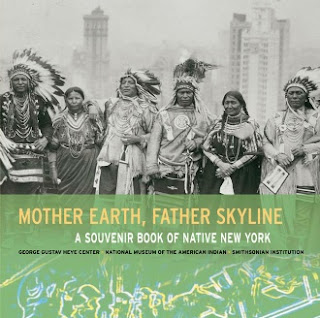Published by the Smithsonian Institution’s National Museum of the American Indian
Mother Earth, Father Skyline: A Souvenir Book of Native New York
Edited by Duane Blue Spruce (Laguna/Ohkay Owingeh)
Mother Earth, Father Skyline: A Souvenir Book of Native New York presents the experiences of Native Americans in the world’s most exciting city. Through photographs, illustrations, and brief essays, Duane Blue Spruce traces the Native presence in New York.
- ISBN-13: 978-1-933565-04-0 (softcover)
- 2006, published by NMAI
- 64 pages, more than 60 color and black-and-white photographs
- 6 x 6 inches
Reviewed by Ramona Kiyoshk
This book offers a look at
urban “Indians” in the Big Apple, from the end of the 19th
century to the present.
Native Americans have always lived in what is now called New York City. Delaware villages dotted the landscape when the Dutch arrived in 1626 and bought “Mannahata” for a string of beads. Since Native peoples had no concept of landownership, this transaction was obviously a misunderstanding; however, the rumor set a standard in Manhattan Island real estate ethics that is still in vogue today.
Duane Blue Spruce (Laguna and San Juan Pueblo), architect and facilities planning coordinator for the National Museum of the American Indian’s George Gustav Heye Center in Manhattan, edited this collection of pictorial essays. Many of the black and white photographs are from archives and offer glimpses of families of ironworkers, performers and artists living smack in New York City’s bustling hub.
While the first Native Americans who came to New York City to perform dressed in war bonnets and beaded moccasins to please the crowds, the average working Indian who made NYC home blended right in wearing styles of the day.
There is a snapshot of the Tallchief sisters, Maria and Marjorie, hamming for the camera on the deck of an ocean liner in New York harbor, while Marjorie’s children watch. Maria was the prima ballerina of the New York City Ballet, marrying and divorcing founder GeorgeBalanchine. She also danced in the American Ballet Theatre in the 1960s. During the 1950s, the Tallchiefs were just two of New York’s stellar ballerinas of Oklahoma Osage heritage.
Coeur d’Alene MildredBailey was a gifted singer and pianist who helped Bing Crosby get his early break. Ms. Bailey performed in New York City’s most prestigious venues to sold out houses, often sharing the spotlight with acclaimed musicians of the era.
Today, more than 90,000 Native Americans live and work in New York City. The American Indian Community House welcomes hopeful newcomers each year and represents 70 Native nations throughout the Americas.
For a surprising glimpse of Native Americans who enhance the color and vibrancy of the New York City mystique, this little book is worth a read. It was assembled by one of the NYC’s native sons, Duane Blue Spruce, who also happens to be a Native American from New Mexico.
Native Americans have always lived in what is now called New York City. Delaware villages dotted the landscape when the Dutch arrived in 1626 and bought “Mannahata” for a string of beads. Since Native peoples had no concept of landownership, this transaction was obviously a misunderstanding; however, the rumor set a standard in Manhattan Island real estate ethics that is still in vogue today.
Duane Blue Spruce (Laguna and San Juan Pueblo), architect and facilities planning coordinator for the National Museum of the American Indian’s George Gustav Heye Center in Manhattan, edited this collection of pictorial essays. Many of the black and white photographs are from archives and offer glimpses of families of ironworkers, performers and artists living smack in New York City’s bustling hub.
While the first Native Americans who came to New York City to perform dressed in war bonnets and beaded moccasins to please the crowds, the average working Indian who made NYC home blended right in wearing styles of the day.
There is a snapshot of the Tallchief sisters, Maria and Marjorie, hamming for the camera on the deck of an ocean liner in New York harbor, while Marjorie’s children watch. Maria was the prima ballerina of the New York City Ballet, marrying and divorcing founder GeorgeBalanchine. She also danced in the American Ballet Theatre in the 1960s. During the 1950s, the Tallchiefs were just two of New York’s stellar ballerinas of Oklahoma Osage heritage.
Coeur d’Alene MildredBailey was a gifted singer and pianist who helped Bing Crosby get his early break. Ms. Bailey performed in New York City’s most prestigious venues to sold out houses, often sharing the spotlight with acclaimed musicians of the era.
Today, more than 90,000 Native Americans live and work in New York City. The American Indian Community House welcomes hopeful newcomers each year and represents 70 Native nations throughout the Americas.
For a surprising glimpse of Native Americans who enhance the color and vibrancy of the New York City mystique, this little book is worth a read. It was assembled by one of the NYC’s native sons, Duane Blue Spruce, who also happens to be a Native American from New Mexico.

